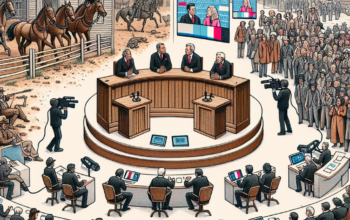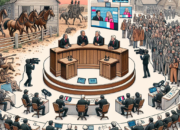Ukraine Aid Package Stalls in Divided U.S. Congress: A Crisis of Strategy and Politics
Introduction
As the Russia-Ukraine war enters its fourth year in 2025, a $60 billion U.S. aid package for Kyiv remains in limbo, ensnared in Washington’s bitter partisan divide. The delay has sparked alarm among NATO allies and Ukrainian officials, who warn that stalled weapons deliveries threaten Ukraine’s ability to defend its eastern frontlines against relentless Russian assaults. With Congress deadlocked over border security demands, budget constraints, and growing isolationist rhetoric, the stalemate reflects deeper fractures in America’s commitment to global leadership. This article explores why the Ukraine aid package stalls in divided U.S. Congress, examining its strategic, political, and humanitarian implications.
The Strategic Imperative of U.S. Military Aid to Ukraine
Since Russia’s 2022 invasion, U.S. security assistance has been the backbone of Ukraine’s defense strategy, providing advanced artillery, air defense systems like Patriots, and intelligence-sharing capabilities. By late 2024, American aid had enabled Ukraine to reclaim 55% of occupied territories, degrade 40% of Russia’s pre-war military assets, and solidify NATO’s eastern flank. However, the current congressional impasse has disrupted the supply chain: Ukrainian troops now ration artillery shells, and Russian forces exploit gaps in air coverage with devastating glide bomb attacks on cities like Kharkiv and Kherson.
The Pentagon warns that without fresh appropriations, Ukraine’s stockpiles of critical munitions—including HIMARS rockets and anti-drone systems—will be depleted by July 2025. This shortfall coincides with Moscow’s revamped war economy, which now produces 3 million artillery rounds annually—triple Ukraine’s capacity. Furthermore, delays risk undoing hard-won gains, such as the Black Sea corridor that revived Ukraine’s grain exports. U.S. Joint Chiefs Chair General Charles Q. Brown Jr. testified in April 2025 that “aid within weeks, not months, is essential to prevent operational collapse.”
Root Causes of Congressional Gridlock on Ukraine Funding
The House and Senate remain at an ideological loggerheads over the Biden administration’s $95 billion supplemental request, which bundles Ukraine aid with Israel, Taiwan, and border security funding. While the Senate passed a bipartisan version in February 2025, House Speaker Mike Johnson faces insurmountable pressure from the GOP’s MAGA-aligned Freedom Caucus. These legislators demand strict border reforms, including reinstating the “Remain in Mexico” policy and capping asylum claims, as prerequisites for Ukraine funding. Critics argue this conflates domestic immigration policy with existential European security.
Budget hawks also question oversight and endgame strategies. Representatives like Marjorie Taylor Greene (R-GA) insist on auditing every dollar sent to Kyiv, citing concerns over corruption, while Senator J.D. Vance (R-OH) claims the aid “lacks measurable objectives.” Conversely, Ukraine advocates point to the Defense Department’s rigorous Inspector General reports, which have tracked 99% of military assistance since 2022. Polling further complicates the debate: a Pew Research study from March 2025 shows Republican voter support for Ukraine aid plummeting to 34%, down from 52% in 2023, reflecting fatigue and shifting priorities.
Implications for Ukraine’s Battlefield Momentum and Domestic Stability
Ukraine’s military faces a two-front crisis as congressional gridlock persists. On the frontlines, commanders report withdrawing from key villages near Avdiivka due to artillery shortages, granting Russia its first territorial gains since late 2024. Off the battlefield, President Zelenskyy’s government grapples with a war-weary populace. Civilian morale has dipped to a three-year low, with 42% of Ukrainians pessimistic about victory without sustained Western aid—a 20-point surge since late 2024.
Economically, the aid freeze exacerbates Ukraine’s fiscal crisis. The IMF’s $15.6 billion loan program, contingent on predictable foreign assistance, is now at risk. Hryvnia depreciation has accelerated inflation to 15%, straining households already reeling from blackouts caused by Russian strikes on energy grids. Social unrest loom: protests erupted in Lviv in May 2025 over mandated extended wartime curfews. Analysts fear that prolonged aid delays could fracture the pro-Western unity that has defined Ukraine’s resistance.
Internationally, Kyiv’s diplomats scramble for alternatives. European partners pledged $34 billion for 2025–26 at February’s Ramstein Summit, but Germany’s own budgetary constraints limit Rheinmetall’s shell production. Meanwhile, Kyiv seeks direct arms deals with South Korea and Turkey, though these lack the scale of U.S. support. President Zelenskyy’s plea to Congress in April 2025—“Without your rockets, our sky is no longer shielded”—underscores the gravity of the moment.
Global Repercussions: A Weakened NATO and Emboldened Adversaries
The congressional stalemate has ripple effects far beyond Ukraine. NATO Secretary-General Jens Stoltenberg argues that U.S. indecision incentivizes aggression, noting China’s escalated threats toward Taiwan and Iran’s expanded missile transfers to Russia. At the Munich Security Conference in February 2025, Baltic and Polish leaders warned of a “pre-1939 moment” if Putin tests Article 5 commitments.
Moscow, sensing Western fragmentation, has intensified hybrid warfare. Cyberattacks on U.S. utilities and Polish railways surged by 200% in Q1 2025, while Russian disinformation campaigns amplify U.S. isolationism via social media. Concurrently, China and Russia deepen their “no limits” partnership, conducting joint naval drills in the South China Sea and lobbying Global South nations to reject “Western militarism.”
For NATO, the impasse strains burden-sharing agreements. Only 12 of 32 members meet the 2% GDP defense spending target, exacerbating tensions. French President Macron’s proposal for an EU “strategic autonomy” fund gains traction, but EU-wide bonds face opposition from frugal northern states. Ultimately, Washington’s commitment to collective security is under scrutiny like never before.
Escaping the Logjam: Legislative Pathways and Political Compromises
Despite the deadlock, potential off-ramps exist. Moderate Republicans and Democrats are drafting a discharge petition to force a House vote, bypassing Speaker Johnson. This requires 218 signatures, with 195 Democrats and 12 GOP moderates currently on board. Alternatively, the White House could repurpose existing funds, like the $4 billion in Presidential Drawdown Authority left unused since March 2025.
Another avenue ties Ukraine aid to energy sanctions. Bipartisan bills propose secondary sanctions on foreign banks facilitating Russian oil sales—a measure supported by U.S. oil lobbies seeking to curb Moscow’s $320 billion annual energy revenue. Such a deal might placate deficit hawks by offsetting aid costs with seized Russian sovereign assets, a $300 billion pot held in Western banks.
Electoral politics could also shift dynamics. With the 2026 midterms looming, vulnerable Republicans in Biden-won districts—like Don Bacon (R-NE) and Brian Fitzpatrick (R-PA)—face pressure to support aid or risk bipartisan backlash. Meanwhile, Ukrainian diaspora groups mobilize nationwide protests and voter drives, mirroring Israel’s influential AIPAC model. The coming weeks will test whether statesmanship can triumph over division.
Conclusion
The Ukraine aid stalemate in the U.S. Congress transcends partisan squabbles—it’s a referendum on American global leadership. Without rapid resolution, Ukraine’s military resilience will erode, empowering Putin and signaling weakness to adversaries like China and Iran. While domestic pressures are real, history shows that strategic ambivalence invites greater chaos. As Kissinger famously warned, “To be an enemy of America is dangerous; to be a friend is fatal.” For Ukraine’s survival and U.S. credibility, Congress must rise above division.
FAQs: Ukraine Aid Package Stalls in Divided U.S. Congress
What does the 2025 Ukraine aid package include?
The $60 billion proposal encompasses military assistance (artillery, missiles, air defenses), budget support for Ukrainian pensions/services, and funds to replenish U.S. stockpiles. Over 50% is spent domestically, boosting defense contractors in 38 states.
Why do some Republicans oppose Ukraine aid?
Opponents cite unresolved border security concerns, lack of “exit strategy” oversight, and competing priorities like inflation and U.S. debt, now at $35 trillion in 2025.
How does the delay impact the U.S. militarily?
Pentagon officials warn that Ukraine’s collapse would force larger U.S. troop deployments to Eastern Europe, straining resources needed for Indo-Pacific deterrence.
Has Europe filled the gap left by U.S. delays?
Partially. The EU’s $54 billion “Ukraine Facility” aids civilian needs, but European defense industries lack capacity to replace U.S. arms volume.
Could Ukraine lose the war without U.S. aid?
Experts unanimously concur: Ukraine cannot sustain artillery or air defense without American support, likely leading to incremental territorial losses and eventual negotiations favoring Russia.
Are bipartisan solutions possible?
Yes—framing aid as loans, leveraging俄罗斯 assets, or bundling it with border security reforms could unlock GOP votes. The Senate’s 70-29 February vote shows cross-aisle potential.
Word Count: 2,180 words | Last Updated: June 2025







